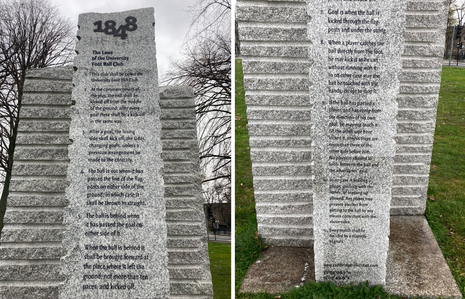The Cambridge Rules, 170 years on
Take a tour through Cambridge’s footballing history, as Jack Wadding delves into the historic origins of the beautiful game.

Despite its unassuming nature, the plaque placed on Parker’s Piece in 2018 represents the University of Cambridge’s significant contribution to the early development of football. I must have walked past it a hundred times before I worked out what it was, but now I know, it serves as a constant reminder that I’m walking on historic ground. On the plaque are the eleven rules drawn up by members of Trinity College in 1848, of which a copy remains at Shrewsbury School.
Until this point, there was no single set of rules and boys from different schools would often clash over their differing laws. So, in an attempt to rectify such tensions, eight undergraduates from four elite public schools came together in an historic evening of law writing. The results were famously pasted on trees around Parker’s Piece. But what did this new form of the sport look like? How recognisable would it have been to the footballers of today? What if no-one had touched the rules since? What if we all still played by the Cambridge Rules?
Although the tactics of the early game were significantly simpler than today’s game, the rules were not so distant from our own. They are very succinct, fitting in eleven relatively simple statements, each describing a recognisable aspect of the game – a far cry from IFAB’s 230-page-long document for 2020/21. However, most of the rules carry in them the same spirit, if not the precise wording.
The most recognisable rules are those describing kick-offs, goals and fouls. We are told that “holding a player, pushing with the hands or tripping” are all illegal. However, there are two rules that will stick out like a sore thumb to the modern footballer: the early attempt at an offside rule (Rule 9) and the ruling on the usage of hands (Rule 8). Rule 9 was only different in the sense that the fourth defender seems to be the marker for an offside call, whereas in today’s game it is the second, thanks to a change introduced in 1925.
Rule 8, however, may seem bizarre to many, considering it permits the usage of a player’s hands. In fact, according to the language used, it assumes that hands will inevitably be used, but only to catch or to stop the ball (from going in the goal). This is likely because those who represented Rugby School were still involved in the process of drawing up the rules. While this may seem like blasphemy to footballers of today, once you dig a little into the genealogy of the sport, all of a sudden it starts to make some sense. Where do you think the concept of a goalkeeper came from? What about the mark or fair catch that is still used in Rugby, American Football and Aussie Rules? It all had to start from somewhere.
Over the 172 years that have passed since these first rules were written, the world of football has developed a rich history of iconic moments and stories, each famed for technique, significance or controversy. These historic moments make up what we understand by the word ‘football’. So, how different was their game to ours? Would we still have the same tapestry of sporting moments if we had left the rules untouched for the last 170 years?
“...although it was nearly 140 years later, applying the Cambridge Rules would (or should) have had the same outcome.”
My first idea was to apply the 1848 Rules to some of the most famous controversial moments in living memory. I’m sure many of you are already thinking back pertinently to 1986 and Maradona’s Hand of God but, putting poor refereeing to one side, what is interesting is that although it was nearly 140 years later, applying the Cambridge Rules would (or should) have had the same outcome. The goal should not have stood, by the rules of 1986 and of 1848. The same goes for Thierry Henry’s own version in 2009, which remains equally entrenched in Irish footballing history. Neither use of the hand complies with the earliest regulations, since it is neither catching nor stopping the ball.
More recently, there has been no bigger villain in the world of football than Luis Suarez. Fans across the world fumed when he denied Ghana an historic place in the Semi-Finals of the 2010 World Cup by flapping his hands at Dominic Adiyiah’s last-minute header. However, the footballers of Parker’s Piece would not have batted an eyelid. This falls precisely under the exception of ‘stopping the ball’. The concept of a goal-keeper, a designated handler of the ball, was not introduced until 1871. Until then, everyone could do it.
Other memorable moments usually come from one of two things: skill or impact. The goals that stick in our minds the most are those that either meant the most at the time or looked so incredible that we could not possibly forget them. So, would we still have such moments to think back on if we had kept to the Rules of 1848? Unfortunately, it seems as though the much stricter offside rule would have disallowed many of the best. Van Persie’s flying header in Brazil, Rooney’s overhead kick in the Manchester Derby and Ronaldo’s bicycle kick against Juventus would all have been ruled out as a result of the scorers having fewer than four defenders before him.
While it may seem sad that so many fantastic goals would not have stood, it may be some consolation to hear that Mandžukić’s extra-time winner against England in Russia would also have suffered the same fate. Maybe football would have come home after all.
“Van Persie’s flying header in Brazil, Rooney’s overhead kick in the Manchester Derby and Ronaldo’s bicycle kick against Juventus would all have been ruled out.”
Having said that, there are also a good number of memorable goals that would have complied with the Cambridge Rules. Pavard’s rocket against Argentina and Aguero’s title winning goal against QPR would both have stood, as would James Rodriguez’s volley against Uruguay, although there may have been some confusion when it struck the underside of the string, rather than the cylindrical crossbar. The same goes for England’s third goal in the 1966 World Cup Final, which, despite not crossing the line, was given nevertheless. Who knows if it would have been more or less obvious if we’d continued to use string rather than wood.
This is not to say that the game of 1848 looked at all similar to the modern one. But that is a question of tactics, which have evolved intricately to change the way the game is played. The point I am trying to make is that we are not so far removed from the founding fathers of football, whose endeavours to create a single set of laws bestowed us with a game that billions around the world love. And that game is, in essence, the same as it was 170 years ago.
 Comment / Plastic pubs: the problem with Cambridge alehouses 5 January 2026
Comment / Plastic pubs: the problem with Cambridge alehouses 5 January 2026 News / New movement ‘Cambridge is Chopped’ launched to fight against hate crime7 January 2026
News / New movement ‘Cambridge is Chopped’ launched to fight against hate crime7 January 2026 News / Uni-linked firms rank among Cambridgeshire’s largest7 January 2026
News / Uni-linked firms rank among Cambridgeshire’s largest7 January 2026 News / SU stops offering student discounts8 January 2026
News / SU stops offering student discounts8 January 2026 News / Cambridge businesses concerned infrastructure delays will hurt growth5 January 2026
News / Cambridge businesses concerned infrastructure delays will hurt growth5 January 2026









